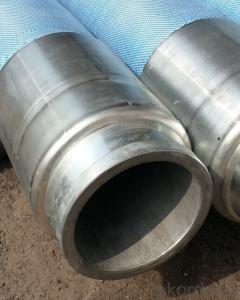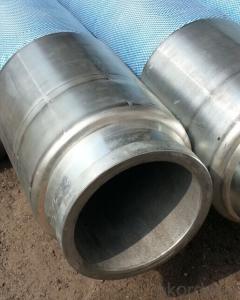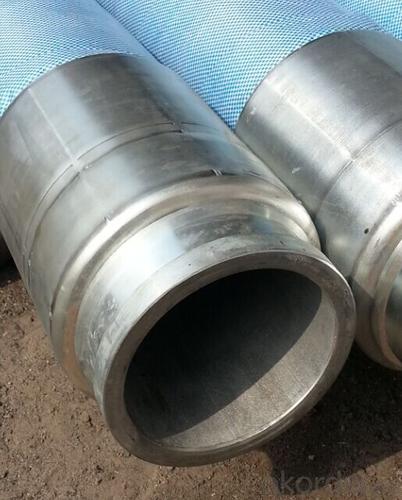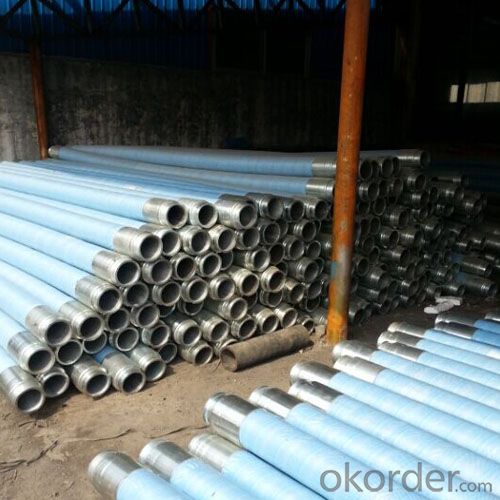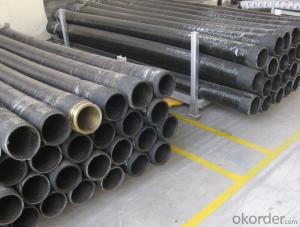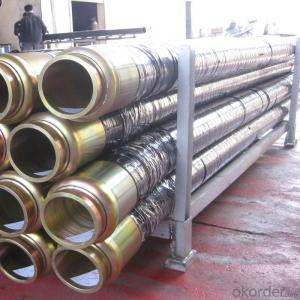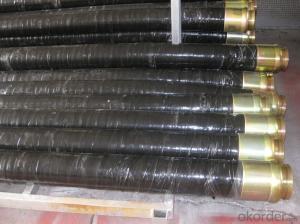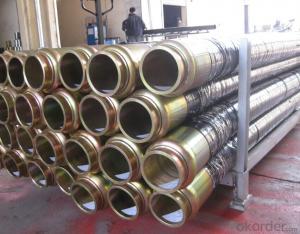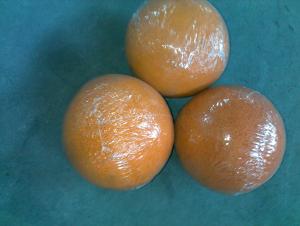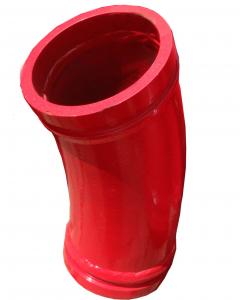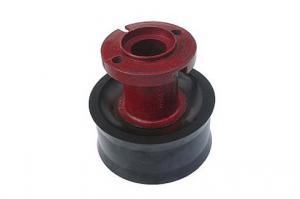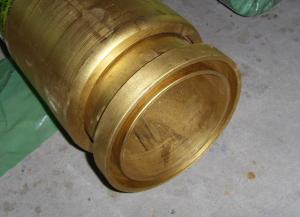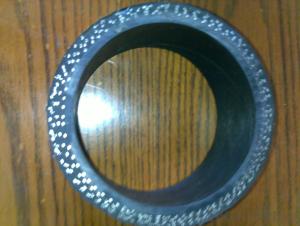Rubber End Hose With Two Side Couplings Working Pressure 85 Bar 3M*DN100
- Loading Port:
- Shanghai
- Payment Terms:
- TT OR LC
- Min Order Qty:
- 10 pc
- Supply Capability:
- 5000 pc/month
OKorder Service Pledge
OKorder Financial Service
You Might Also Like
Product Description:
The 3M*DN100 rubber end hose with two side couplings, normally the hoes is made by NR and reinforced by four layer steel wire, and the two couplings at each side are made by steel material No.ST52, 20#, 37MN5, with hot treatment according to customer’s requests, and also package in bundles or nude packing directly put into container.
Scope of Application of the hose
The 3M*DN100 rubber end hose is a concrete delivery for combined use with other concrete pipelines in concrete placement operations. It can be widely used in the construction of various types of concrete structures like industrial and civil buildings, bridges, roads, and other types of infrastructure.
Product Advantages:
OKorder's 3M*DN100 rubber end hose Channels are durable, strong, and safety. We are the biggest group in this business filed and the majority resources are under our control, which is make sure the delivery time and qualified products, meanwhile we have more than 20 overseas branches our people will go to visit customer very fast for more convenient communication.
Main Product Features:
Premium quality
· Prompt delivery & seaworthy packing (5-10 days)
Reliable performance·
Professional Service
· Competitive pricing
Measuring of wall thickness from the outside
FAQ:
Q1: How soon can we receive the product after purchase?
A1: Within three days of placing an order, we will book the vessel for goods. The specific shipping date is dependent upon international and government factors, but is typically 7 to 30 workdays.
Q2: If we can produce some pipes according to customers request?
A2: Yes, we can produce Concrete Placing Boom according to the difference country situations to make it suitable to the market and customers. We have very professional technical team to make the design.
Q3: How to make a quick resolution for after service?
A3: OKorder and our manufacture both have overseas branches all-around of world, if needed,
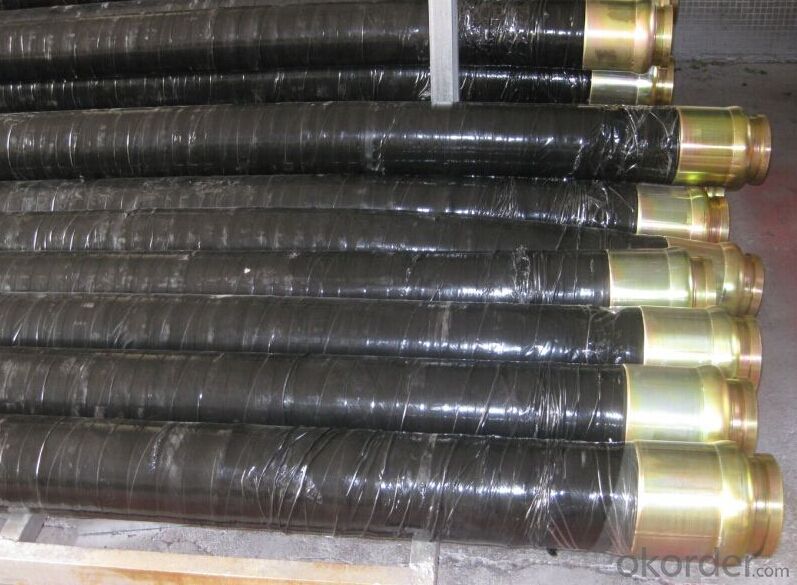
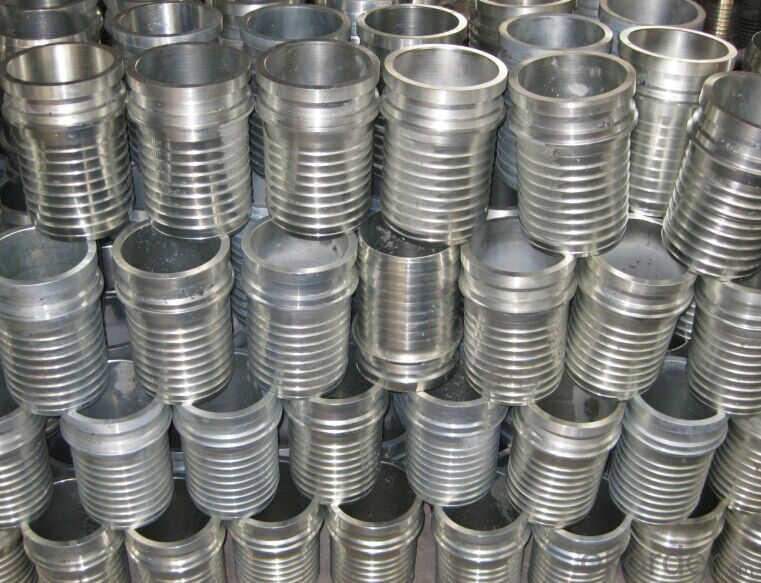
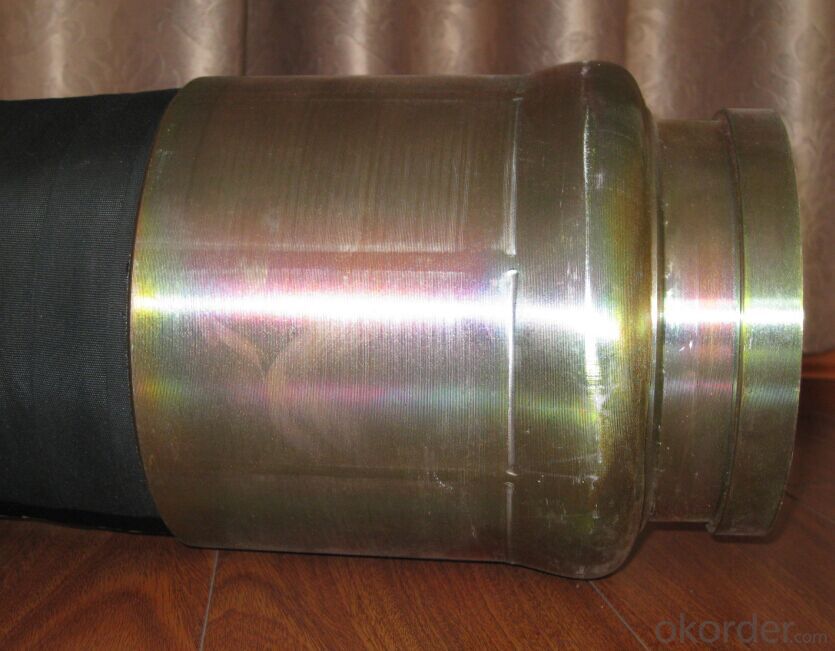
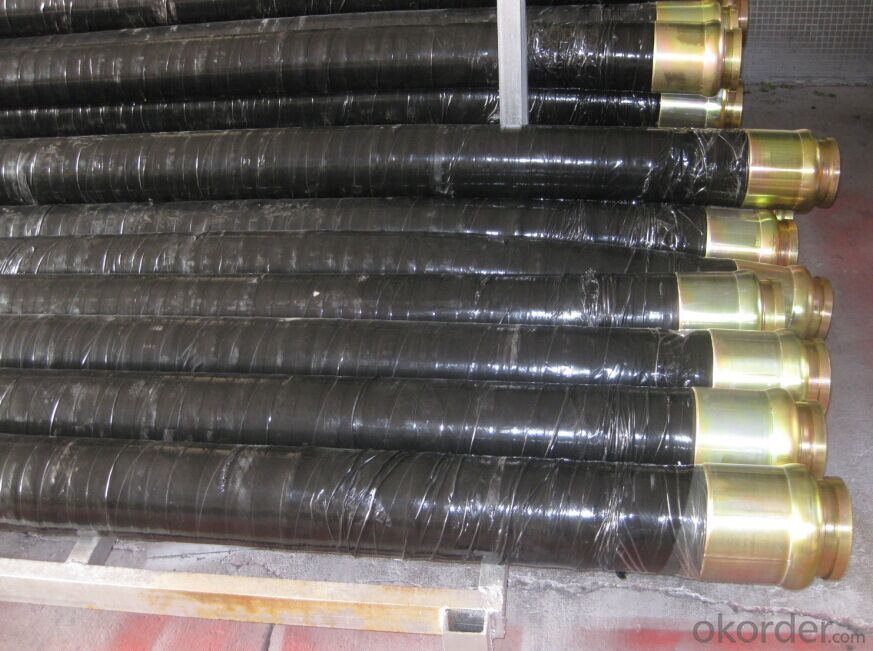
- Q: What are the advantages of using pre-assembled spare parts for concrete pumps?
- There are multiple benefits to utilizing pre-assembled spare parts for concrete pumps. To begin with, the use of pre-assembled spare parts guarantees a swift and efficient replacement process. As these parts come already assembled, they can be effortlessly installed without the need for additional time or effort to assemble them. This helps to reduce downtime and increase productivity on construction sites, as the concrete pump can be swiftly repaired and put back into operation. Additionally, the utilization of pre-assembled spare parts ensures a high level of quality and compatibility. These parts are produced by the original equipment manufacturer (OEM) or authorized suppliers, guaranteeing that they meet the necessary standards and specifications. By employing authentic pre-assembled parts, the performance and longevity of the concrete pump are maintained, minimizing the risk of malfunctions or breakdowns. Another advantage is the cost-effectiveness of pre-assembled spare parts. While the initial cost of these parts may be slightly higher than individual components, they often prove to be more cost-effective in the long run. By purchasing pre-assembled parts, construction companies can avoid the extra costs associated with assembly, such as labor and time. Additionally, using high-quality pre-assembled parts reduces the need for frequent replacements and repairs, saving money on maintenance and downtime expenses. Furthermore, pre-assembled spare parts offer convenience and reliability. Construction projects frequently have strict deadlines, and any delays can be expensive. By having pre-assembled spare parts readily available, construction teams can promptly address any breakdowns or failures, minimizing disruptions to the project timeline. Additionally, the reliability of these parts ensures that the concrete pump will consistently and efficiently operate, reducing the risk of unexpected issues on the construction site. In conclusion, the advantages of utilizing pre-assembled spare parts for concrete pumps encompass quick and efficient replacement, high quality and compatibility, cost-effectiveness, as well as convenience and reliability. By adopting these pre-assembled parts, construction companies can ensure smooth operations, minimize downtime, and maximize productivity on their projects.
- Q: What are the signs of a damaged concrete pump S valve?
- There are several signs that indicate a damaged concrete pump S valve. 1. Leakage: One of the most common signs of a damaged S valve is leakage. If you notice any fluid or concrete leaking from the S valve, it could be an indication of a damaged or worn-out seal or gasket. 2. Reduced pumping efficiency: A damaged S valve can lead to reduced pumping efficiency. You may notice that the concrete flow is not as smooth or continuous as before, and it may take longer to pump the same amount of concrete. 3. Increased pressure: When the S valve is damaged, it can result in increased pressure within the pump system. This can cause strain on other components of the pump and lead to further damage or malfunction. 4. Unusual noises: Another sign of a damaged S valve is the presence of unusual noises during pumping operations. You may hear grinding, squeaking, or other abnormal sounds that indicate a problem with the S valve mechanism. 5. Difficulty in switching directions: The S valve is responsible for controlling the flow direction of the concrete. If you experience difficulty or resistance when switching the direction of the concrete flow, it could be a sign of a damaged S valve. 6. Inconsistent concrete flow: A damaged S valve can cause inconsistent concrete flow, resulting in uneven distribution or blockages in the delivery line. This can lead to delays and inefficiencies in the construction process. It is important to address any signs of a damaged S valve promptly to prevent further damage and ensure the safe and efficient operation of the concrete pump. Consulting a professional or the manufacturer's guidelines is recommended for proper diagnosis and repair of the S valve.
- Q: How does a hopper vibrator prevent concrete blockages?
- A hopper vibrator serves as a mechanical solution to avoid concrete blockages in construction equipment like concrete pumps and mixers. Its purpose is to apply vibrations to the hopper, which is the large container where the concrete is stored prior to pouring or transferring. Concrete blockages commonly occur due to the tendency of the material to settle and compact, particularly during prolonged storage or transportation. This can result in the clogging and obstruction of concrete flow, thereby impeding the construction process and potentially causing equipment damage. Through the utilization of a hopper vibrator, the vibrations are transmitted to the concrete within the hopper, effectively preventing settling and compaction. The vibrations loosen the concrete particles, ensuring they remain in a more fluid state. This facilitates a continuous and smooth flow of concrete, preventing any blockages or obstructions from arising. Furthermore, the vibrations from the hopper vibrator also aid in dislodging any existing blockages. The shaking motion can break apart concrete clumps or other debris obstructing the flow, enabling uninterrupted material movement. Overall, a hopper vibrator is an indispensable tool in construction equipment as it helps maintain a consistent concrete flow, thereby preventing blockages and ensuring the smooth and efficient operation of the construction process.
- Q: How often should hopper grate springs be inspected or replaced in a concrete pump?
- Hopper grate springs in a concrete pump should be inspected regularly, ideally on a monthly basis, to ensure their proper functioning. However, the actual replacement of these springs depends on various factors such as the usage intensity, wear and tear, and manufacturer's recommendations. It is essential to monitor their condition closely and replace them promptly if any signs of damage or fatigue are observed.
- Q: How long does it take to receive concrete pump spare parts after placing an order?
- The time it takes to receive concrete pump spare parts after placing an order can vary depending on various factors such as the availability of the parts, shipping methods, and the location of the supplier. However, it typically takes anywhere from a few days to a couple of weeks for the parts to be delivered. It is always advisable to check with the supplier or manufacturer for a more accurate estimate based on your specific order.
- Q: Why would the plugging concrete pump pipe
- When pumping, the choice of speed is critical, operators can not blindly map fast, sometimes more haste, less speed. When pumping for the first time, due to the large resistance of the pipeline, the pump should be pumped at low speed. After the pump is normal, the pump speed can be increased properly
- Q: Are there any online resources or manuals available for concrete pump spare parts?
- Indeed, the online realm offers a plethora of resources and manuals for concrete pump spare parts. Numerous manufacturers and suppliers of such components have established their own websites, which furnish comprehensive details concerning their products, encompassing manuals, catalogs, and technical specifications. It is worth noting that these websites often dedicate sections or pages specifically for spare parts, facilitating the acquisition of information pertaining to diverse types of spare parts, their compatibility with various pump models, and the process of ordering them. In addition to the aforementioned manufacturer websites, there exists a profusion of online marketplaces and directories that specialize in construction equipment and spare parts. These platforms empower users to conduct targeted searches for concrete pump spare parts, enabling the comparison of prices and specifications provided by different suppliers. Furthermore, some of these platforms offer supplementary resources, including user reviews, ratings, and guides to assist in selecting the appropriate spare parts for a given pump model. Moreover, online forums and communities cater to professionals in the construction industry, furnishing platforms for the exchange of information and discussions concerning concrete pumps and their spare parts. These forums serve as invaluable resources for obtaining recommendations, resolving common issues, and connecting with experts capable of offering guidance on sourcing and maintaining spare parts for concrete pumps. Overall, regardless of whether one is a concrete pump operator, maintenance technician, or an individual seeking spare parts for a concrete pump, the online domain abounds with resources that can provide the necessary information and manuals.
- Q: Can I get spare parts for concrete pump hydraulic systems?
- It is indeed feasible to acquire spare parts for hydraulic systems of concrete pumps. Numerous manufacturers and suppliers present an extensive selection of spare parts exclusively crafted for concrete pump hydraulic systems. These spare parts encompass hydraulic cylinders, valves, hoses, filters, seals, and other indispensable components. To guarantee compatibility while procuring spare parts, it is crucial to ascertain the precise make and model of the concrete pump hydraulic system. Moreover, it is advisable to obtain spare parts from trustworthy suppliers or manufacturers to assure excellent quality and dependability.
- Q: Can concrete pump spare parts be repaired on-site, or should they be sent to a specialized repair facility?
- Concrete pump spare parts can be repaired on-site in certain cases, while in others it may be necessary to send them to a specialized repair facility. The decision of whether to repair on-site or send for specialized repair depends on the nature and complexity of the repair required, the availability of skilled technicians and equipment, and the time constraints of the project. In many cases, minor repairs or replacements of simple components can be carried out on-site. These may include tasks such as replacing hoses, seals, or filters, which can be done quickly and easily with basic tools and equipment. These types of repairs can often be performed by the operators or maintenance personnel themselves, without the need for specialized technicians. However, for more complex repairs or replacements, it is advisable to send the spare parts to a specialized repair facility. This is particularly true for critical components such as hydraulic cylinders, valves, or control systems, which require specialized knowledge and expertise to repair properly. Specialized repair facilities have trained technicians who specialize in specific equipment and are equipped with the necessary tools and resources to diagnose and fix complex issues. Moreover, specialized repair facilities often have access to a wider range of spare parts and can source genuine parts from the original manufacturer. This ensures that the repaired spare parts are of high quality and compatible with the specific make and model of the concrete pump. Additionally, these facilities may offer warranties on their repairs, providing peace of mind to the equipment owners. Ultimately, the decision to repair on-site or send for specialized repair depends on the specific situation and resources available. It is important to assess the complexity of the repair, the availability of skilled technicians, and the potential impact on the project timeline before deciding on the most appropriate course of action.
- Q: How can one ensure proper alignment and positioning of concrete pump spare parts during installation?
- Achieving the desired alignment and positioning of concrete pump spare parts during installation is crucial for the pump's efficient and safe operation. Here are some important steps to follow: 1. Familiarize yourself with the manufacturer's instructions: Before starting the installation process, carefully read and understand the instructions and guidelines provided by the manufacturer. These instructions will give you specific information on how to align and position the spare parts for your concrete pump model. 2. Prepare the work area properly: Clear any debris, dust, or obstacles from the work area that could hinder the installation process. A clean and organized work environment will make it easier to accurately position and align the spare parts. 3. Use appropriate lifting equipment: Concrete pump spare parts can be heavy and require special lifting equipment to prevent damage or injuries. Utilize cranes, hoists, or forklifts to lift and position the spare parts accurately and safely. 4. Employ precise measuring tools: Invest in high-quality measuring tools like laser levels, alignment guides, and precision measuring tapes. These tools will help you ensure precise alignment and positioning of the spare parts during installation. 5. Verify dimensions and specifications: Before installing any spare part, compare the dimensions and specifications provided by the manufacturer with the actual part. This will help you identify any discrepancies or potential issues that need to be addressed before installation. 6. Follow a systematic installation process: Begin with the main components of the concrete pump and gradually proceed to the spare parts. Follow a step-by-step approach, meticulously aligning and positioning each spare part according to the manufacturer's instructions. 7. Seek professional assistance if necessary: If you are uncertain about the proper alignment and positioning of certain spare parts, don't hesitate to seek professional assistance. Consulting experienced technicians or contacting the manufacturer's customer support can provide valuable guidance and ensure correct installation. 8. Perform a final inspection: Once all the spare parts are installed, conduct a thorough inspection to verify the alignment and positioning. Check for any visible gaps, misalignments, or irregularities. Immediately address any issues to ensure the proper function and longevity of the concrete pump. By following these steps and paying attention to detail, you can guarantee the proper alignment and positioning of concrete pump spare parts during installation, resulting in a dependable and efficient pump system.
Send your message to us
Rubber End Hose With Two Side Couplings Working Pressure 85 Bar 3M*DN100
- Loading Port:
- Shanghai
- Payment Terms:
- TT OR LC
- Min Order Qty:
- 10 pc
- Supply Capability:
- 5000 pc/month
OKorder Service Pledge
OKorder Financial Service
Similar products
Hot products
Hot Searches
Related keywords
